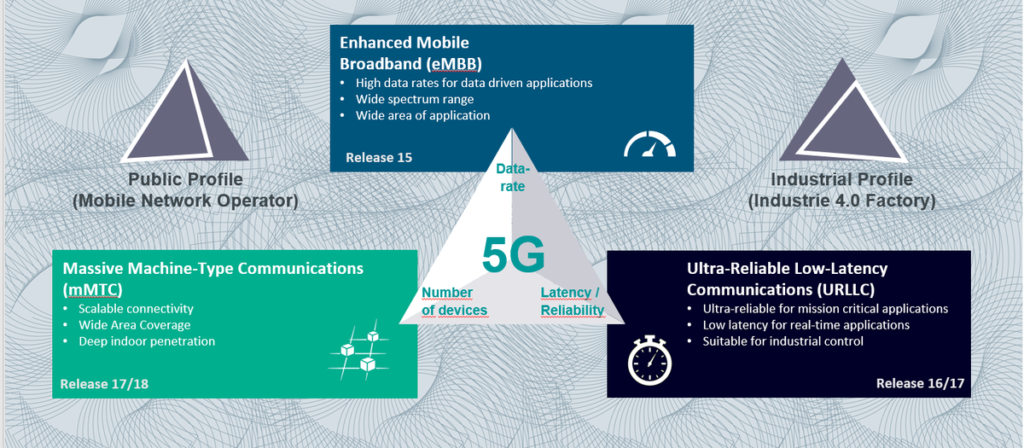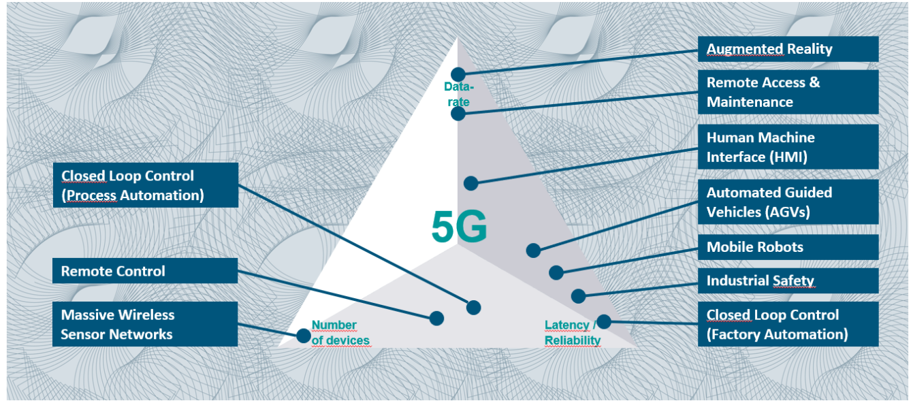 First-generation mobile phone networks were analog systems that provided just enough bandwidth for voice calls. Introduced in the early 1990s, 2G was the first digital mobile technology, while 3G in the late 1990s made it possible for handsets to carry email messages and provide rudimentary access to web pages. It was not until the adoption of 4G technology in 2008 that real smartphone capability was enabled: 4G mobile broadband led to the development of smartphone apps, the proliferation of multimedia and streaming services, and access to high speed internet on-the-go. The recent installation of 5G networks marks the first time that a new generation of mobile technology has been built around the needs of machines and systems rather than handset users. The telecommunications industry’s plan for 5G envisaged technical breakthroughs in three main parameters:
First-generation mobile phone networks were analog systems that provided just enough bandwidth for voice calls. Introduced in the early 1990s, 2G was the first digital mobile technology, while 3G in the late 1990s made it possible for handsets to carry email messages and provide rudimentary access to web pages. It was not until the adoption of 4G technology in 2008 that real smartphone capability was enabled: 4G mobile broadband led to the development of smartphone apps, the proliferation of multimedia and streaming services, and access to high speed internet on-the-go. The recent installation of 5G networks marks the first time that a new generation of mobile technology has been built around the needs of machines and systems rather than handset users. The telecommunications industry’s plan for 5G envisaged technical breakthroughs in three main parameters:
- Latency, reliability, and determinism
- Connection density
- Bandwidth and the speed of data transfer
The reason for enhancing performance in these parameters was to enable real-time monitoring and control of dense concentrations of devices communicating concurrently. In a smart city scenario, for instance, 5G is expected to enable real-time information about the location of available on-street parking spaces to be displayed in the navigation system of cars in the vicinity. Such a smart parking system will require the simultaneous connection of thousands of proximity sensors or cameras and thousands of cars in a small area, continually transferring real-time data about space availability and location.
The requirement of this and other applications for latency, density, and bandwidth is met by three technology enhancements embodied in the 5G standard specifications:
- Ultra-reliable low latency communication (URLLC) for real time-control systems
- Enhanced mobile broadband (eMBB) to support new bandwidth-dependent use cases, including augmented and virtual reality
- Enhanced/massive machine type communications (eMTC) for low power, wide area wireless networking
 These 5G technology features make it capable of supporting the requirements of factory control systems for real-time determinism and six nines (99.9999%) availability. Yet the real-world experience of most mobile handset users accessing 2G, 3G, or 4G networks still involves black spots where coverage is weak or nonexistent, and of occasional and unpredictable dropped connections.
These 5G technology features make it capable of supporting the requirements of factory control systems for real-time determinism and six nines (99.9999%) availability. Yet the real-world experience of most mobile handset users accessing 2G, 3G, or 4G networks still involves black spots where coverage is weak or nonexistent, and of occasional and unpredictable dropped connections.
So is there a realistic prospect that mobile phone technology will be used to connect mission-critical, time-sensitive industrial machines?
Replacement of the Mature 4–20 mA Technology
For all the hype around state-of-the-art 5G technology, the reality is that most process equipment installations today include a provision for control via mature wired 4 mA to 20 mA links—a proven, dependable technology that dates back to the 1950s. This speaks to industry’s need for certainty and the avoidance of risk when implementing mission- or safety-critical control systems.
But the tides of change cannot be beaten back forever, and innovations in the way factories operate give control system designers good reason to evaluate alternatives to 4 mA to 20 mA technology. As Industry 4.0 and other global phenomena accelerate the pace at which factory operations evolve, two trends are driving the introduction of new networking technologies: the introduction of autonomous mobile machinery and the development of more flexible manufacturing facilities to meet growing consumer demand for personalized or configured products.
In factory and warehouse settings, the use of autonomous guided vehicles (AGVs), cobots, and other types of autonomous mobile devices offer an effective way to increase efficiency and productivity. As automated equipment takes on the burden of performing repetitive and mundane tasks, workers are freed to transfer to higher value and more interesting factory operations that machines cannot perform.
The new generation of autonomous mobile devices such as AGVs requires a wireless communications connection that offers low latency for real-time control, high bandwidth to carry the signals from multiple sensors such as LIDAR scanners and video cameras, and high immunity to interference—the hallmarks of 5G mobile networks.
When factory operators replace wired with wireless connections, they also gain the flexibility to quickly reconfigure factory equipment to meet new or varied demands from consumers. The rise of e-commerce raised expectations from consumers for near-instant delivery of ordered products and for the ability to choose from a wider range of product options than ever before. The ability to move production or process equipment more quickly and easily is growing in value. A fixed, wired communications infrastructure is less flexible than a wireless network to which equipment can connect from any location. Wireless networks also reduce the cost, inconvenience, and technical difficulty involved in installing communications cabling.
Over the long-term, then, factory operators are open to the benefits of wireless control capability alongside established wired communications technologies. In the immediate future, however, industry must prioritize its most important requirements, which are:
- High reliability and availability
- Security
- Robustness to cope with challenging industrial operating conditions
- Ultralow latency
These factors underlie the longevity of the 4 mA to 20 mA standard for factory communications. And while factory operators are looking to replace 4 mA to 20 mA technology, their focus today is on the implementation of the time sensitive networking (TSN) standard for wired Industrial Ethernet communications, rather than for anything wireless.
TSN has emerged as the preferred standard for high bandwidth, wired data communications in the factory, since it offers the ideal combination of reliability, robustness, a high data transfer rate, low latency measured in microseconds, and easy integration with enterprise IT network systems.
And because the TSN specification is a standard benefiting from cross-industry support, it is rapidly developing a rich ecosystem of suppliers of TSN components and systems, which includes Analog Devices.
OpenRAN: Non-Public Networks Enable the Validation of Claims Made for 5G Performance
Alongside the implementation of TSN networks, the scope for enhancing factory operations through the implementation of wireless networking is also coming under active evaluation. Some early adopters in the industrial community have already begun the work of testing, validating, and evaluating the operation of 5G networking systems inside the factory, while concurrently replacing legacy 4 mA to 20 mA systems with new TSN Ethernet networks. This validation process will find the most suitable applications for 5G technology.
So factory operators are now starting to test the innovative features of the 5G specification, such as massive MIMO capability—the use of arrays of antennas to provide multiple physical transmission paths between a transmitter and receiver. An array may be configured to form multi-antenna beams transmitting to multiple receivers. This allows the implementation of techniques such as channel hardening, beamforming, rapid channel estimation, and antenna (spatial) diversity, the effects of which are to dramatically improve reliability and reduce latency compared to 4G mobile networking.
Indeed, one of the aims of the developers of the 5G standard was to enable wireless networks to achieve six nines reliability for packet delivery, comparable to that of a wired Ethernet network, and equivalent to a packet error ratio of 1:1,000,000. Latency of just 1 ms is also possible, which is well within the limit imposed by many industrial control applications.
The question is, can this performance be achieved in the real-world conditions experienced inside a factory, where communications equipment might be subject to multiple sources of high amplitude radio frequency interference, transient voltage events, high temperatures, and other disturbances?
In validating the real-world performance of a 5G installation, factory system designers have a choice: they can, of course, take advantage of 5G coverage provided by mobile network service providers. But the 5G standard also makes provision for the implementation of private systems, or so-called non-public networks (NPNs) that cover, for example, an industrial campus or a large factory complex. Different industrial users and use cases will favor a different choice of public or private network.
The implementation of 5G networking in the factory is also facilitated by developments from mobile network operators of the OpenRAN (Open Radio Access Network) specification. This has opened the market for 5G radio and core equipment to a broader range of suppliers in addition to those which traditionally served the telecoms equipment market. This has the potential to broaden the choice of equipment available to meet the needs of use cases different from those of mass-market public network operators and to encourage the development of 5G products by suppliers that are focused on the industrial market.
As a supplier of physical layer components and protocol software to manufacturers both of TSN equipment and of 5G infrastructure, Analog Devices hereby assesses the prospects of each technology for implementation in industrial control systems. While the immediate future belongs to wired Industrial Ethernet technology, it is easy to imagine a future where AGVs and robots inside the factory transmit and receive time- and mission-critical data payloads via a 5G network—and the availability of 5G network coverage means that this is an actual rather than a theoretical possibility today.

 Brendan O’Dowd
Brendan O’Dowd